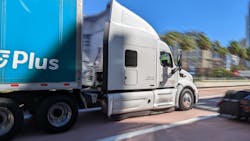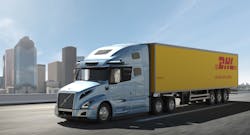Fleets begin to get a feel for the future of moving freight
Large fleets are starting to get a feel for the future of humanless freight transportation. As various autonomous trucking technology companies and truck makers team up, they are starting to show how the middle mile could transform supply chains and create more home time for the human drivers on their payrolls.
While some of these fleets are going with the OEMs that supply their equipment, others are opting to be part of pilot programs with the technology companies that are penetrating the trucking world with promises of robot trucks hauling freight 24/7 across the Sunbelt in the U.S. The autonomous freight moving right now through these pilots and other test programs has human safety drivers on board, who must adhere to hours-of-service rules and other regulations. But the AV companies are still saying that humans could be gone in the coming years. Until then, it’s about testing out lanes and logistics.
Doug Veatch, VP of strategy at 10 Roads Express (No. 32 on the FleetOwner 500: Top For-Hire Fleets), said his fleet chose to partner with Kodiak Robotics because the self-driving truck company has a similar approach to safety as the for-hire carrier. “The other reason we picked Kodiak is that their product offering might be able to fit in a little better with organizations that are OEM agnostic,” he said of the Kodiak Driver, the autonomous technology that is designed as an upfit for trucks.
“We’re remaining flexible,” Don Burnette, Kodiak’s CEO and founder, told FleetOwner. “We have a platform-agnostic system. We’ve designed the Kodiak Driver to work across multiple manufacturers and multiple models of trucks. We think that’s very important.”
See also: Kodiak shows how its self-driving trucks handle tire blowouts
Veatch said that Kodiak’s modular upfit approach could help his fleet find earlier applications than just focusing on a single make and model tractor, which is how some OEMs are developing AV technology.
Volvo Group, which operates Volvo Trucks North America here, is working with autonomous technology company Aurora Innovation to develop AV-powered trucks in the factory. Aurora has partnered with other OEMs, including Kenworth and Peterbilt. The AV company also has partnered with FedEx Corp., Werner Enterprises, Schneider, and other fleets as it develops its technology.
“We are confident in our strong path to market, differentiated technology, and industry-leading team, and we continue to believe autonomous technology will be the next fundamental change in ground transportation,” said Chris Urmson, Aurora CEO and co-founder.
Daimler Truck is working with Waymo to develop its factory-built self-driving Freightliner Cascadia. And Daimler Truck North America also has a majority stake in Torc Robotics, the oldest self-driving technology company in the U.S.
Creating safer, human-less freight movement
10 Roads, a fleet provider for the U.S. Postal Service, has used Kodiak trucks with Kodiak safety operators on board to move freight more than 5,500 miles—from San Antonio, Texas, to the Bay Area in California, to Jacksonville, Florida, and back to San Antonio. The first run was completed in 114 hours. “That’s what we’ve done with them so far this year,” Veatch said. “We’ve been working on finding those lanes as we ramp up to do a little more. But the focus this year was on the coast-to-coast trip.”
Veatch sees the emerging autonomous technology as the next step in the advanced driver assistance systems that are emerging in the trucking industry. “We’ve seen all these advances in technology over the last few years with the lane departure, the crash avoidance—even the camera technology used to identify sleepy or distracted drivers,” he explained. “I think this is the next step in that evolution. The industry has been working on improving safety overall for several years with these improvements. I think this is just the natural progression of using all those technologies together to really start looking at how we can operate more safely.”
See also: Embark prepares coast-to-coast autonomous trucking network
With that safety would also come a better work-life balance for his drivers, which Veatch believes the technology would supplement—not replace. “In this day and age, drivers want to have home-daily jobs. That’s what I hear a lot,” he explained. “I think by taking that middle mile and possibly being able to leverage some of the autonomous technology, that makes better jobs for drivers. It also may create more jobs for drivers because you can move more product to the road that is perhaps not on the road today. I think it has the potential of really doing good things for the drivers in the industry.”
Peter Voorhoeve, president of Volvo Trucks North America, said the AV technology development “will go fast—but it’s not a race.” He told FleetOwner he expects the technology to mature quickly, but he wants the focus to be on safety and supplementing fleet operations.
“I think there are a lot of companies that see the application of driverless hub-to-hub operations as complementary to what they’re doing today rather than pushing drivers out of the truck—because that is not going to happen,” he said.
Self-driving journey ahead
Sasko Cuklev, director of autonomous solutions at Volvo Trucks, told FleetOwner that the OEM is working on “an industrialized, scalable solution with safety in mind.”
“We want this product to come out of our New River Valley factory assembly line autonomous-enabled,” Cuklev said. “We are not focused on being first. What we are aiming at is a scalable solution, a commercially viable solution that will solve real-world problems. We will do this together with our customers and support our customers in their transformation.”
One of Volvo Group’s early AV test partners is DHL (No. 67 on FleetOwner 500: For-Hire). DHL Supply Chain and Volvo Autonomous Solutions began working on a hub-to-hub program earlier this year using Aurora-equipped Volvo VNL autonomous trucks.
“We see huge potential in advanced technology solutions like autonomous trucks to address the needs of our customers around efficiency, reliability, and increased capacity, which only hastened during the pandemic,” said Jim Monkmeyer, president of transportation for DHL Supply Chain North America. “But our collaboration aims higher than an autonomous truck. We hope our partnership with Volvo will help shape a safer and more sustainable future for all.”
But when will fleets actually be able to move freight without human drivers or safety operators on board? Most AV companies are still eyeing the middle of this decade.
VTNA’s Voorhoeve doesn’t have a specific timeline other than to say “second part of this decade,” he told FleetOwner. “That does not mean 2029, by the way, but maybe it also is not March 2026. This is technology that is really new, and we really need to take the time to do this in a good way.”
Volvo’s Cuklev noted that there are all sorts of safety-driver-monitored AV trucking demonstrations across the U.S. “But to take the step to operate 24/7 in a long contract every day, have a reliable solution, and a safe solution, we are not really there yet,” he said.
He said that Volvo is still focused on the truck side of the technology “so that we have a secondary or a redundant braking system, a steering system, power management system, communications, and so on. [We need to] have that in place so that we eventually can remove the safety driver. But we are not really there yet. From a demo perspective, it works perfectly fine. I was in one the other week between Dallas and Houston—it worked perfectly. But there is still a journey ahead in order to make it commercially ready.”
But 10 Roads’ Veatch is being patient.
“It’s hard to know when the technology will be both commercially available and broadly accepted in the courtroom of public opinion,” he said. “I’m not sure anybody really knows when those will happen. Our goal is to take this time to be prepared to integrate the AVs when appropriate.”
For 10 Roads, it all comes back to safety and drivers, Veatch said. “There’s really no excuse at the end of the day when drivers don’t get to go home,” he emphasized. “So if there’s technology that will help with that, we want to be on board with it. That’s something that’s very important to the 10 Roads family.”
Recent autonomous trucking developments
It's been a busy year for autonomous trucking technology companies and partners. Here is a look at some of the progress and milestones various players in the space have made since late 2021.
Daimler Truck is developing a scalable autonomous truck platform for Waymo Via for the Freightliner Cascadia tractor. The focus is on safety redundancies within the braking system, steering system, low-voltage power network, and communications.
According to Daimler Truck, if a fault is deemed critical to the vehicle's operation, the autonomous driving system will allow the truck to follow a safety protocol and execute a "minimal risk maneuver" to come to a safe stop.
The two companies began testing the technology on public roadways in Texas this summer. Like with other OEMs, the goal is to build the Waymo technology into Daimler trucks that fleets can purchase directly from the truckmaker.
One of the first self-driving technology companies in the U.S., Torc Robotics was also one of the first autonomous trucking companies to create an advisory council full of industry leaders. The Torc Autonomous Advisory Council, announced on March 29, includes Baton, C.H. Robinson, Covenant Logistics, Penske Truck Leasing, Ryder System, Schneider, and OEM Daimler Truck North America, which has a majority stake in the robotics company.
The company said these industry partners would help Torc achieve its goal of being the first scalable, profitable, commercialized Level 4 AV truck solution in the market.
To help with that scaling, Torc also tapped Penske Truck Leasing as its official maintenance service provider. "Our objective is to integrate our trucks into the existing freight industry, and we are confident that a current industry leader, like Penske, will provide crucial support in doing just that," Michael Fleming, Torc's founder and CEO, said.
Mega fleet Schneider is also teaming up with Torc to move freight. The pilot operations will allow Torc to get direct feedback from Schneider on the technology. "We see great potential for Torc's autonomous technology to improve freight efficiencies while helping to lower cost," said Rob Reich, EVP and chief administrative officer at Schneider
Knight-Swift Transportation, one of the largest carriers in the U.S., became the first fleet to own and maintain Embark Trucks' autonomous tractors. Knight-Swift was the first fleet to join Embark's Truck Transfer Program, which it is developing for fleets to purchase autonomous equipment. During the tests, the Embark-powered trucks will operate with Knight-Swift drivers on board to provide feedback on the technology to help the company define how it could improve driver jobs.
Embark Trucks also developed a way for law enforcement to interact with driverless trucks during roadside inspections and other stops. Working with the Texas Department of Public Safety and the Travis County Sheriff's Office, Embark-powered trucks can now identify and stop for law enforcement vehicles. Embark also built communication protocols and standard operating procedures for autonomous trucks to interact with law enforcement during traffic stops.
A public demonstration occurred in late June on Texas State Highway 130 near Austin. Travis County's Commercial Vehicle Enforcement division deputies followed an Embark-powered truck along a designated route and successfully completed a traffic stop of the Embark truck.
A deputy confirmed the truck was safe to approach via an external status display on the side of the truck, then walked through the procedure of accessing the truck's documentation via an external lockbox, using a code that a remote Embark Guardian support technician would provide. (See video of the interaction.)
While most AV companies are working toward removing the humans from the truck cabs, Plus is taking a different approach. The company is building its PlusDrive suite of autonomous driving solutions, from highly automated driving to fully autonomous driving, that it has already deployed to customer fleets for use in commercial freight operations.
"The idea is that we deploy this system at scale and provide immediate gains for fleets," said Anurag Ganguli, VP of R&D at Plus.
PlusDrive yields 10% or more fuel savings, in addition to boosting safety and increasing driver retention through increased driver comfort, Ganguli said.
With PlusDrive, truck drivers stay in the cabin to oversee the autonomous driving technology, but they do not have to actively drive the vehicle. Instead, they can turn on PlusDrive to automatically move the truck on highways in all traffic conditions, including staying centered in the lane, changing lanes, and handling stop-and-go traffic.
To assist customers using TuSimple's "driver-out" Level 4 autonomous mode, the AV trucking technology provider paired Werner Enterprises' roadside service support system with TuSimple's Autonomous Freight Network earlier this year. This is intended to provide TuSimple's customers with immediate roadside service or expedited maintenance.
Locomation is developing an electronically tethered, two-truck convoy that uses a human-guided autonomous solution that enables one driver to operate the lead truck, while a second driver rests in the self-driving that follows, and said its technology will have a positive environmental impact.
An independent study of its Class 8 operations, released late last year, said the Locomation system could reduce freight transportation's carbon footprint by 22%, cut operating costs by 19%, and decrease fuel consumption by 21%. Its trucks saw an 8% fuel efficiency gain, according to the Boundless Impact Research & Analytics study.
Broker C.H. Robinson and Waymo began working together this year to use self-driving trucks to bolster freight networks used by C.H. Robinson shipper customers. "It does lay the groundwork for us to explore C.H. Robinson's freight network, the largest in North America, being among the earliest to use Waymo Via's L4 autonomous driving tech," Chris O'Brien, chief commercial officer at CHR.
Kodiak Robotics and logistics firm CEVA Logistics teamed up to make the first autonomous truck deliveries in Oklahoma, the two companies announced in March. This route runs 200 miles between a CEVA facility in Dallas and the delivery point in Oklahoma City. Kodiak's AV fleet has been hauling freight for CEVA, between Dallas-Fort Worth and Austin, Texas, since 2021. On both routes, a Kodiak safety driver is on board.
Uber Freight and Waymo began working together this year to connect their technologies to deploy autonomous trucks on the Uber Freight network. For example, fleets that purchase Waymo Driver-equipped trucks could deploy their autonomous assets on the Uber Freight network, which provides experience for onboarding, load booking and execution, trailer transfers, and payment in an ecosystem where human drivers and autonomous trucks can collaborate in a hybrid network to move freight, the companies announced in June.
Uber Freight also partnered with Aurora Innovation to expand their autonomous pilot with a new commercial lane between Fort Worth and El Paso. The 600-mile lane across Texas launched in October and is supporting Uber Freight customers as they prepare for the 2022 holiday season.
About the Author
Josh Fisher
Editor-in-Chief
Editor-in-Chief Josh Fisher has been with FleetOwner since 2017. He covers everything from modern fleet management to operational efficiency, artificial intelligence, autonomous trucking, alternative fuels and powertrains, regulations, and emerging transportation technology. Based in Maryland, he writes the Lane Shift Ahead column about the changing North American transportation landscape.




